Excerpts from Jim Conrad's
Naturalist Newsletter
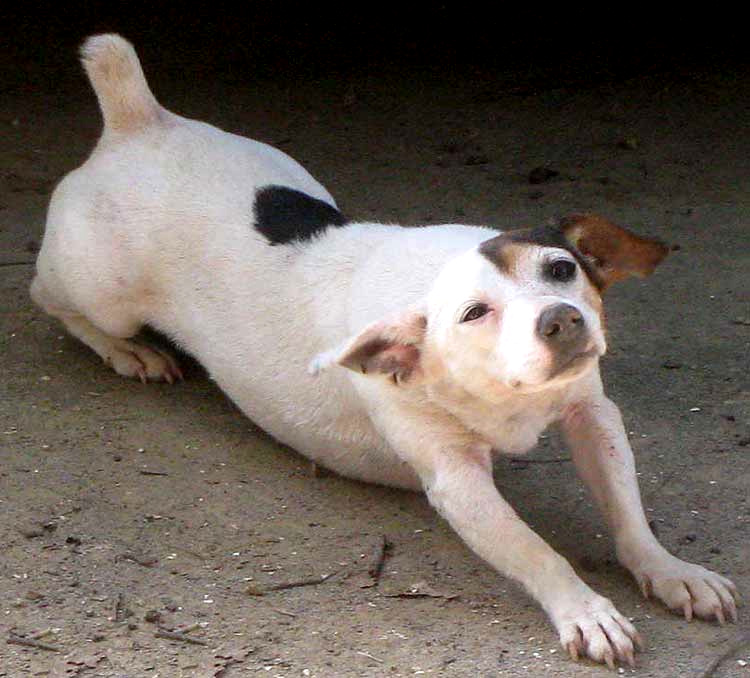
from the July 8, 2012 Newsletter issued from the woods of the Loess Hill Region a few miles east of Natchez, Mississippi, USA
DOG STRETCHING
Maggie the Jack Russell Terrier, bred to be loyal to the alpha dog, waits for me outside whatever door I happen to have entered last. As soon as I exit she rouses herself from her snooze, gets up and stretches exactly as is shown above. She does this so consistently, day after day, that I have to think that stretching is important to her, and maybe to me, too.
On the Internet you can find pages describing how to massage and stretch your dog before competitions and shows when the dog needs to perform flawlessly. Just search on the keywords "dog stretching" and you'll see. Massaging and stretching "keeps the dog well-balanced, both physically and psychologically, allowing it to retain the agility of the young dog well into an advanced age," one page says.
The more lazy dogs here only occasionally stretch. However, Maggie is an obsessive hunter and very active. Apparently such active dogs need to be ready for action at a moment's notice, so as they were bred, their stretching predisposition was maintained.
New research shows that in humans stretching may not be as important as we've been led to believe, except for athletes about to push their bodies to the limit. However, about a year ago I developed an Achilles tendon problem so painful that I feared I'd have to give up jogging. But then at the Hacienda I met a podiatrist who showed me a simple stretching exercise to do before every run, and the pain almost vanished in a few days.
So, stretching may well be another of those many things that can be of great value to us, even though they're free. Certainly Maggie not only feels compelled to stretch, but obviously enjoys it. A good stretch feels good to me, too.
Have a good stretch yourself, and just notice the pleasant feeling.
Entry dated July 4, 2023, issued from near Tequisquiapan; elevation about 1,900m, (6200 ft), ~N20.57°, ~W99.89°; Querétaro state, MÉXICO
CHICO'S UNDERWATER SNIFFING

Each time Chico the former Mexican-village streetdog, mostly a Weimaraner, passes by a body of water, he lunges into it, plunges his nose beneath the water, and looks very much like he's sniffing. As he walks forward, he moves his head back and forth, exactly as he would if sniffing for something on dry ground.
The Internet is full of stories about dogs sniffing underwater, even of dogs being trained to locate underwater drug packets, cadavers and more. But other web pages insist that dogs can't small underwater. In the 2021 study by Agata Kokocińska-Kusiak and others entitled "Canine Olfaction: Physiology, Behavior, and Possibilities for Practical Applications," it's confirmed that dogs can find human traces in water, but it's not stated outright that dogs can smell underwater. Maybe in scientific work the term "smell" isn't well enough defined for some people to use. To most of us, though, dogs can indeed smell underwater.
When you consider how dog noses are constructed, it's easy to believe that they smell underwater. Wikipedia's Dog Sense of Smell page tells us that dogs have roughly forty times more smell-sensitive receptors than humans. Moreover, in the nose, the receptors are spread over an area about the size of a handkerchief, compared to the human's postage-stamp area. To top it off, dog skulls contain two, tiny holes in the roof of their mouths allowing them to pull in a scent without inhaling, which are thought to enable odors to be detected while underwater.
from the June 16, 2008 Newsletter issued from the woods of the Loess Hill Region a few miles east of Natchez, Mississippi, USA
DOG KIDNEY STONES
Some months ago Karen's elderly dog Cody, a small Schnauzer, got deathly ill. The vet removed the kidney stones you can see below.
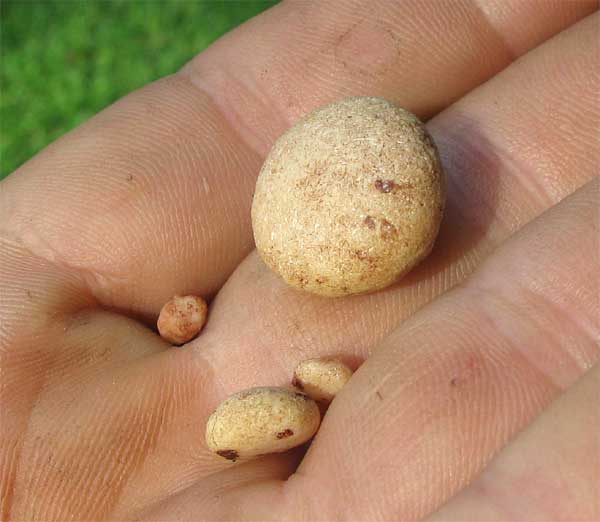
After the operation Cody made a full recovery.
from the November 9, 2003 Newsletter issued from the woods of the Loess Hill Region a few miles east of Natchez, Mississippi, USA
DOG VISION
This week Newsletter subscriber Hillary Mesick on Mississippi's Gulf Coast wrote to me about how nice his old German shepherd, Heidrick, is. That got me thinking about the fine dogs of my own life, back when I lived on the Kentucky farm. When on Wednesday afternoon we got a little shower and a rainbow came out, the combination of dog-talk and rainbows brought to mind my online book, Walks with Red Dog. In that book there's a short chapter called Rainbow, where I describe the different ways Red Dog and I reacted to a certain rainbow many years ago. You can read it at www.backyardnature.net/r/reddog13.htm
In that story I mentioned the opinion current at that time that dogs were practically colorblind. Even back then I knew that this idea was a matter of debate, so I wondered whether by now the issue had been settled. With a bit of creative Googling I got my answer.
First of all, we need to remember that the postage-stamp-size region at the back of the eye receiving light through the lens and translating light energy into electrical impulses the brain can understand is called the retina. The retina is composed of millions of slender RODS and CONES stacked vertically like the fibers of a carpet.
Rods are for seeing in dim light and for detecting movement. They send the brain only gray, fuzzy images, but they can react to a single photon. Cones are a thousand times less sensitive then rods, but with enough light they enable us to see colors and fine detail.
It turns out that the dog's central retina area contains about 20% cones, while humans eyes in that area possess 100% cones. In other words, a dog's daylight vision is considerably less sharp than a human's, but its night vision and ability to notice movement is much better. In daylight, a dog's ability to see detail is around six times poorer than an average human's. All this makes sense when you recall that dog ancestors were mainly nocturnal hunters. Now to the colors.
As noted, colors are discerned by cones. Humans have three kinds of cones, which makes sense when you remember that all colors can be represented by mixing different combinations of the prime colors red, blue and green. Now, here's the thing: Dogs only have two kinds of cones, not three. Therefore, dogs can see some colors, but not all of them. The dog's world consists of yellows, blues, and grays -- no reds or greens.
After that storm many years ago Red Dog may have seen an arc of yellow light in the sky, tinged with a milky blue, but he observed no rainbow in all its glory the way I did. If you'd like more detail on dog vision check out https://www.akc.org/expert-advice/health/are-dogs-color-blind/
from the June 15, 2006 Newsletter issued from Polly's Bend, Garrard County, in Kentucky's Bluegrass Region, USA
MAXINE THE SMELLY MALTESE
Maxine is Ruth's little, white, long-haired, Maltese lap-dog. Usually she runs around fluffy and clean with little hair-clasps keeping the hair from her face. She's the most dainty, girly kind of dog you can imagine.
Still, sometimes she halfway acts like a real dog. For example, the other day she found a newly hatched nestling who had fallen from its nest, died, and had lain in the sun long enough to be stinking. Maxine wallowed in it, pink hair-clasp and all. She did a good wallowing, too, luxuriating in it lying on her back, paws skyward, her head thrown back and wiggling her spine like a snake.
Maxine had just been washed and fluffed so Ruth wasn't tickled at all. I didn't think much about it, just assuming that dogs do it because they like the odor. However, Ruth was skeptical of the idea and for several days she thought on the matter. Finally she came up with this hypothesis:
Dog's wallow in carrion so that when they return to their dens the rest of the pack can smell exactly what's been discovered -- probably what kind of animal has died, how much of it there is, and certainly its stage of decomposition. With this information they can decide whether it's worth following the newly arrived smeller the next time he or she goes out.
Well, that sounds like good reasoning to me and I wonder why I haven't read it someplace before, and why I didn't think of it myself.
from the May 28, 2017 Newsletter issued from Rancho Regensis north of Valladolid, Yucatán, MÉXICO
DOG FEET
One day as Chichan 'Cho' slept beside me I began noticing the bottoms of his feet. They were normal dog feet, but the longer I looked at them, the more curious they seemed. Below, you can see the bottom of Chichan 'Cho''s left, front paw:
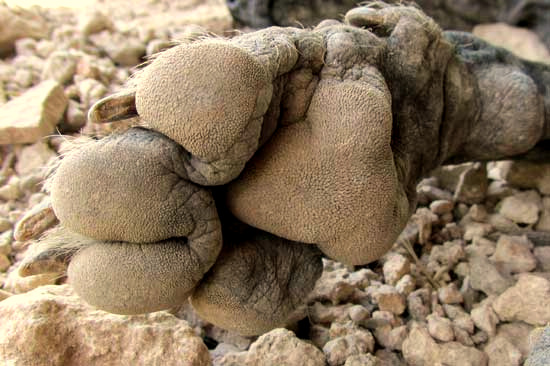
Among vertebrate animals, the feet/hands/paws of the vast majority of species bear five digits, but in the above picture, Chichan 'Cho''s paw seems to have only four. And does the pad at the picture's left side represent a single, deeply divided digit with each section equipped with one part of a split claw, or are we seeing two digits united at their bases? To be sure what I was seeing I had to search on the Internet for pages dealing with dog foot evolution.
It turns out that dog feet feature the normal five digits, but the fifth digit is much reduced and set apart from the pads at the foot's bottom. In the above picture, the fifth one arises from the leg's side near the picture's top, right corner. Below, a side shot of Chichan 'Cho''s leg better shows this appendage's position:
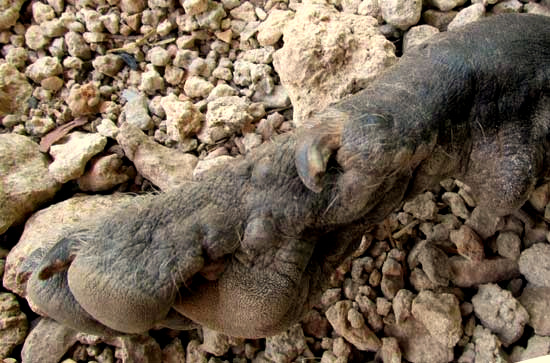
The claw arising from a dog's leg just above the bottom four toes is called the dewclaw. In evolutionary terms it's analogous to the human hand's thumb. In the past, people thought that dog dewclaws were purely vestigial -- useless evolutionary hangovers. However, nowadays it's recognized that dewclaws actually are important because they help prevent torque, or twisting, on the leg when the dog is galloping and making tight turns. Remember how motorcycles lean going around sharp curves, with the tires threatening to slip out from below. When dogs are making such turns, their dewclaws grab the dirt, holding the leg in place.
Once you start thinking in evolutionary terms, other features of the normal dog paw become more understandable. For one thing, the spongy pads at the very bottom serve as shock absorbers.
Slower-running animals such as us humans tend to place our whole foot on the ground, with a rolling heel-to-toe action. Animals displaying that kind of foot action when running are called "plantigrades." Dogs are "digitigrades," meaning that they only walk and run on their digits, which translates to faster running. Humans evolved to jog along for long distance; dogs evolved so they could move very fast for short distances, by "running on their toes."
By the way, horses developed this toe-running feature to an even greater extreme. The horse's bottom-most foot part is a single modified toe, analogous to the human hand's middle, longest finger. The hoof is that toe's fingernail. This arrangement and their longer legs enable horses to run even faster than dogs, at least for short distances
from the February 11, 2018 Newsletter issued from Rancho Regensis north of Valladolid, Yucatán, MÉXICO
NEGRITA'S FAVORITE WEED-NIBBLE
Often the rancho's dogs can be seen eating dirt and nibbling on vegetation. One assumes the dirt provides minerals that may be missing in their regular dogfood diet, and the plants they eat might be medicinal. For awhile I've been noticing that Negrita the black dog never passes a certain weed without stopping for a nibble, so this week as we approached that weed I got the camera ready so, below, you can see her at work:
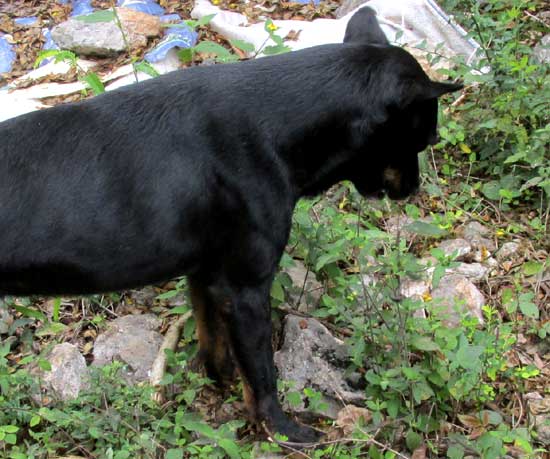
In the past I couldn't identify to species level the typically flowerless and fruitless herbs eaten by dogs, and without an identification there's nothing noteworthy about saying that a dog has eaten a weed. This time, however, when I went to see what she'd been eating, it turned out to be a species we looked out just last month, the Composite or Sunflower Family member Aldama dentata.
So, what does Aldama dentata offer that's so seductive to Negrita that she can't pass it without nibbling on it? On the Internet I find that anthropologist Alejandro Magaña found the Chontal Maya in Mexico's Tabasco state fusing Aldama dentata to deal with high cholesterol. But that didn't seem likely to account for Negrita's fondness of the plant.
Crushing a leaf brought forth no particular odor, and it tasted like any ordinary leaf. However, in tasting it, I did experience one notable sensation, and that is that the leaves were very rough on the lips and tongue. Looking at a leaf surface with a hand lens revealed what's shown below:
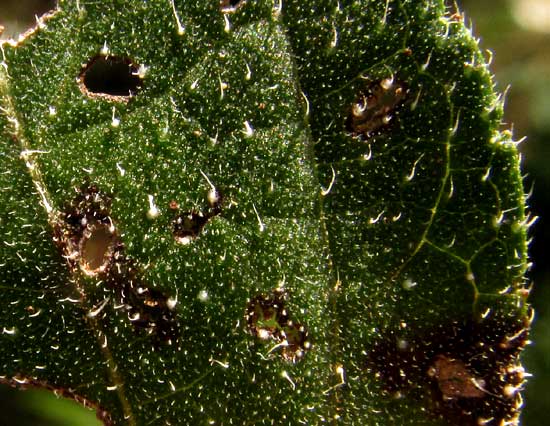
At the microscopic level, the leaves are armored with stiff, sharp, broad-based hairs looking like they could rip into the soft belly of a munching caterpillar or, for that matter, discomfit any leaf-munching invertebrate. Maybe these sharp hairs would wreak havoc on a dog's population of intestinal worms.
At the Pets.WebMD.COM webside I found a discussion on why dogs eat grass. That topic might bear on Negrita's behavior because often grassblades are similarly equipped with sharp, stiff hairs. It's suggested that dogs may eat grass to cause themselves to vomit, though less that 25% of dogs who eat grass vomit after "grazing." Other suggested reasons for eating grass included improving digestion, treating intestinal worms, or fulfilling some unmet nutritional needs, such as the need for fiber. Also, possibly certain dogs simply like how grass tastes or feels.
Of those possibilities, I think the most likely reason for Nigrita habitually eating scratchy Aldama dentata leaves is to help control intestinal worms.
from the November 9, 2003 Newsletter issued from the woods of the Loess Hill Region a few miles east of Natchez, Mississippi, USA
ATTACKED BY DOGS
Last weekend a filling fell from one of my molars so on Thursday I biked to town for an appointment with a dentist. A neighbor had offered to drive me, and other neighbors would have done so had I asked, but I don't like to be a bother, and if I have a real emergency I'll certainly ask.
Right after crossing Sandy Creek I was attacked by two large German Shepherds. One dog seemed content just chasing and barking but the other clamped down on my right leg and foot again and again. Having jogged for about 25 years and biked for about 50, I've been attacked by dogs plenty of times, but this was something far beyond anything I've ever experienced. The attack continued for nearly a quarter of a mile. Since I was biking uphill and much of the time the dog was pulling backward on my leg, finally I grew very tired and a bit dizzy. I've read enough Jane Goodall to know that the script called for them to bring me down, then go for the throat. It is a bit chilling to be aware that you are prey and that your attacker is getting the upper hand.
I managed to stop the bike with the dog hanging onto my leg, and as I began lifting the bike to hit the dog with it, he understood what was going on and retreated out of reach. Then a car came up from behind, the dogs slinked away and I continued on to town 12 miles away. I got about 15 puncture wounds from the affair and my best trousers were ruined with a tear and a large bloody spot. I bled onto the dentist's chair. At the Sheriff's Office I gave a report and said that I expected the dog owners to pay for a new pair of trousers and any medical expenses that develop. Friends tell me that here not only are there no leash laws but dogs are not required to have shots.
I wish I knew what would have happened if I had been a smaller, less fit person. Because of my hypoglycemia and the stress of the moment, if I had passed out, might they really have killed me? The one who kept attacking seemed to be absolutely crazed. I hit him in the face with my heel several times -- a kick that has sent other dogs rolling into the ditch -- but it only seemed to excite this one.
Web pages on canine behavior basically explain dog behavior in terms of "stimulus and response," with a pinch of pack-hierarchy dynamics thrown in. One fairly readable site surveying dog behavior is at www.canismajor.com/dog/packdyn.html
Maybe this is what happened to me Thursday: The dogs saw me pass by. Dogs are programmed to chase prey, so my passage was a stimulus that occasioned their response of running after me. The dominant dog, perhaps considering it his duty to lead the attack, to maintain his alpha position, bit me. My heel across his face was a stimulus leading to a "protective aggression response" and more attacks. Finally it was blind conflict at the most elemental level, them against me, to the natural end.
When I returned from town, blood still draining into my shoe, I carried something in size between a stick and a fencepost. When the dogs attacked this second time I jumped from the bike, steadied my feet, and called "Here, doggie, doggie, doggie... "
At some point the outside world always pushes the disciples of philosophy, liberality, the broad view of things and the spiritual quest... to the point where one must either yield up the right to exist in dignity, or else plant one's feet on solid ground and fight. It always happens, always throughout human history, at every level of existence, whether it be the Mongol Hoards, Nazis, fundamentalist fanatics, transnational captains of the military-industrial complex or just this backwoods family inflicting dogs like this onto the local community. Always.
But now these dogs would come no closer than 20 feet and I walked my bike past their home as they circled howling like savanna jackals just beyond a campfire's light. I understood stimulus and response, and that these were someone's pets, and that now with my stick I was Alpha Dog, and though it can bother me to swat a mosquito, if those miserable beings that had been bred by humans to express some of the most abhorrent of human tendencies had come just a little closer, with little ceremony I would have bashed their brains out.